 We both struggled to get what we wanted. I wanted a picture and the hummingbird wanted food. The bird came back to the feeder again and again, despite my presence just five feet away. I'd fire off a shot and scare the little guy off. He'd come back for his meal and we'd repeat. After I got a few shots worth keeping, I let the bird eat his fill. Bounced flash fired by wireless trigger.
We both struggled to get what we wanted. I wanted a picture and the hummingbird wanted food. The bird came back to the feeder again and again, despite my presence just five feet away. I'd fire off a shot and scare the little guy off. He'd come back for his meal and we'd repeat. After I got a few shots worth keeping, I let the bird eat his fill. Bounced flash fired by wireless trigger.
Showing posts with label Cumberland Plateau. Show all posts
Showing posts with label Cumberland Plateau. Show all posts
Monday, April 18, 2011
Mmm ... nectar
 We both struggled to get what we wanted. I wanted a picture and the hummingbird wanted food. The bird came back to the feeder again and again, despite my presence just five feet away. I'd fire off a shot and scare the little guy off. He'd come back for his meal and we'd repeat. After I got a few shots worth keeping, I let the bird eat his fill. Bounced flash fired by wireless trigger.
We both struggled to get what we wanted. I wanted a picture and the hummingbird wanted food. The bird came back to the feeder again and again, despite my presence just five feet away. I'd fire off a shot and scare the little guy off. He'd come back for his meal and we'd repeat. After I got a few shots worth keeping, I let the bird eat his fill. Bounced flash fired by wireless trigger.
Labels:
Cumberland Plateau,
Fauna,
Strobes
Wednesday, August 18, 2010
Under the stars
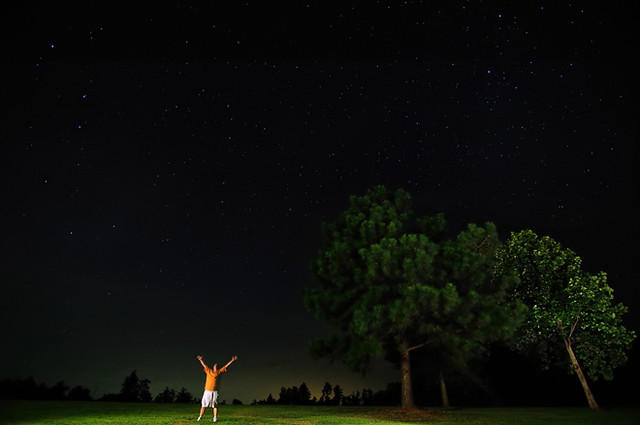
Self portrait under a starry sky.
My wife and I visited my daughter, who lives in a rural part of Tennessee. Far from city lights that pollute the night sky. Clear nights provide a spectacular star show that I love to capture on camera. This photograph was made in one exposure, with no Photoshop other than to adjust levels a tad.
It took an hour or so to set up and choreograph this shot. I set up the camera on a tripod and framed the shot with an ultra wide angle lens while it was still light. Placed a flash on a stand just outside the frame to the left. Identified the spot in which I needed to stand.
When it was sufficiently dark (nearly pitch black), I set the camera to a 30 second exposure. The flash (fired by a wireless trigger on camera) was set to go off at the end of the exposure. That gave me 30 seconds from the time I hit the shutter to use a handheld flash unit to light the trees (five pops of the flash), find my mark, place the handheld flash unit behind me and hit a pose before the final flash went off. The advance planning paid off. It only took three or four tries to get a frame that I liked.
Ah, the things I do for my art.
Extra points if you can find the Big Dipper. The big dip is in the orange shirt.
Photograph © 2010 James Jordan.
Labels:
Cumberland Plateau,
Experimental,
Fun,
Night Photography,
People
Friday, January 08, 2010
12 significant photographs #3
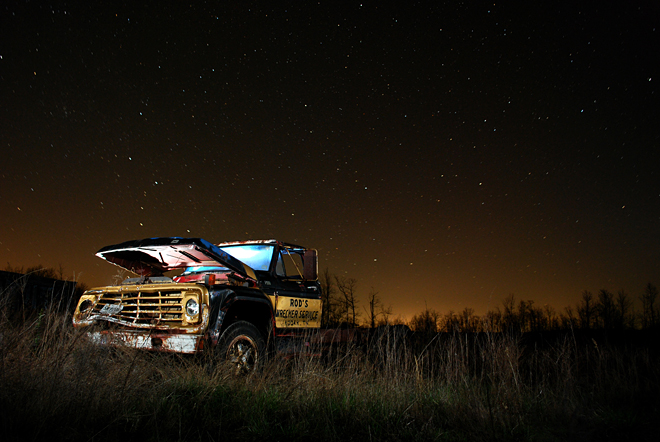
Under the stars. Made on March 29, 2009.
Only a handful of times do I recall being in the presence of something spectacular with a camera in hand and thinking to myself, "Don't screw this up." The first time it happened, I screwed up. I was photographing the lighthouse in Escanaba, Michigan at sunset. After the sun slipped below the horizon, the sky exploded in a golden afterglow, bathing everything in an eerie yellow light. I shot two rolls of film of everything I could to capture the otherworldly sights before me. When the film came back from the photo finisher, I was angry -- they had managed to make all of the shots look, well, ordinary. Where was the yellow?
I stormed back to the lab and asked why they printed the pictures that way. "We just print what's on the negatives," was the reply. Determined to show these morons the errors of their ways, I took the negatives to another lab and asked for a contact sheet -- straight prints, no adjustments, no hank-panky from smartypants technicians to ruin my shots. To my dismay, there was no yellow to be seen on the contact sheet either -- actually, there was almost nothing to be seen at all. I thought back to how I metered the exposure in the golden twilight and realized I compensated for the diminishing light in the wrong direction -- instead of underexposing from the meter reading, I overexposed by two stops. I basically was the proud owner of two rolls of nothing. The fact that the first lab got any pictures to come out at all should have earned them a medal, not my scorn.
Where was I going with that story? Oh, yeah. For most of us shutterbugs, the spectacular happens only very rarely. Unless maybe you live on a mountaintop or a rainforest or are a storm chaser or something. The rest of us lead fairly ordinary lives. For us, the trick is to find ways to make the ordinary look extraordinary. It can be done. Either through relationship of the subject to its surroundings, angle, lighting, distance -- the name of the game is to try to look at old things in new ways.
Visiting family in Tennessee last spring, I became enamored with some old trucks abandoned in a field nearby. I spent night after night with a tripod and a hand held flash unit trying to get something interesting to show up on my camera. I'd set the camera for a long exposure, then trigger the flash from different angles to create the picture. After two nights I didn't have much to show for my efforts.
The third night, I set out again. When I shoot at night, I usually set the camera low on a tripod -- usually no more than a foot off the ground. It makes the night look more imposing. As for exposure, instead of keying on the trucks, as I had the previous nights, I set the exposure to catch the night sky. While the camera's shutter opened for the 30 seconds necessary to get the stars to register, I ran around the truck with my flash, firing six or seven bursts of light, finishing off with a burst in the cab with a blue filter placed over the flash head.
Other than adjusting contrast, the image above is as it came out of the camera. The orange glow in the sky came courtesy of the lights in a town about ten miles away.
So an ordinary truck in an ordinary setting (in Tennessee, at least) became extraordinary by picking the time and method of making the image.
Photograph © 2009 James Jordan.
Monday, October 12, 2009
In storage

An old truck (just barely) protected from the elements. Seen near Viola, Tennessee. Black and white conversion of a color photograph. Created a Hue/Saturation adjustment layer in Photoshop to adjust gray tones.
Photograph © 2009 James Jordan.
Friday, August 21, 2009
Liquid light
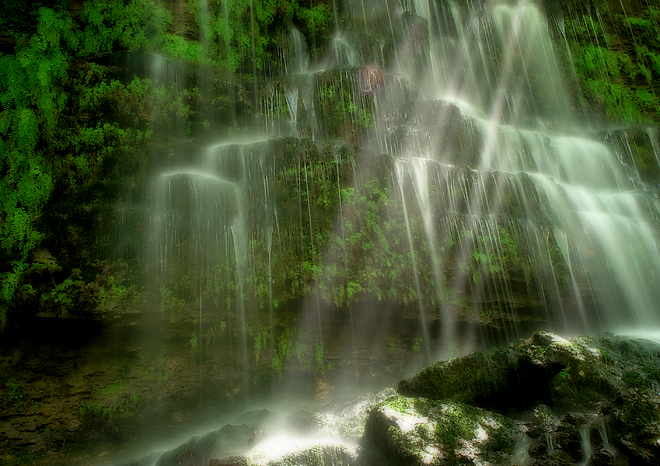
Visitors to Tennessee's Rock Island State Park rave about its natural beauty, especially a series of cascades which tumble down the face of Great Falls Gorge into the Caney Fork River. In actuality, the falls at Rock Island are man made. When the Tennessee Valley Authority built a dam and power station on the Caney Fork River at Rock Island, the Collins River, adjacent to Caney Fork, rose and began to pour over the north face of Great Falls Gorge. Hey, but I'll take 'em.
This shot was taken at the bottom of a trail that leads from a parking area to the base of the gorge. It's a minor cascade, but I was taken by the lush green vegetation and the shafts of sunlight filtering through the trees.
I began a trek to the Great Falls, the largest waterfall in the park, located a half mile up the gorge, which was within sight the entire time. However, the challenging rocky terrain in the open sun and hundred-degree-plus heat index made me reconsider and retreat back to a cooler location. Several vultures circling overhead added to the ominous atmosphere. Aparently one visitor to the park fell victim to heat exhaustion that day while trekking to the falls and an ambulance was called in.
I guess Great Falls will have to wait.
Photograph © 2009 James Jordan.
Labels:
Cumberland Plateau,
Orton,
water
Wednesday, August 19, 2009
Pasture, Northcutts Cove, Tennessee
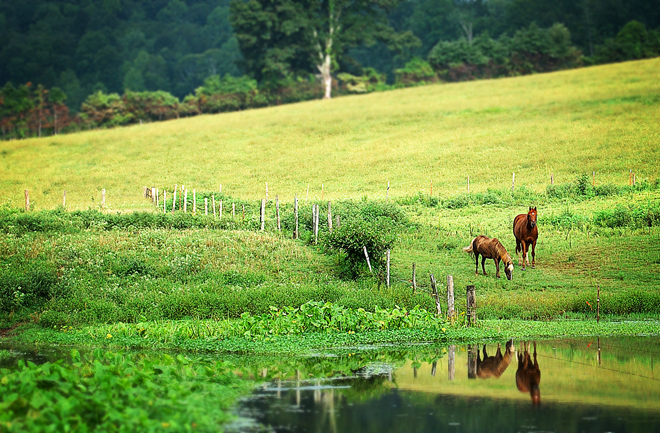
Another "had to stop" moment on a drive through Northcutts Cove, just off Tennessee's Cumberland Plateau. I saw the horses, the hills and the pond and that was it. Brakes applied.
It took a while to arrive at a composition I was happy with, and also to catch the horses at the right angles. They were wandering about, crossing in front of each other or just plain turned wrong. I wanted them separated slightly and facing somewhat the same direction. Another horse on the other side of the fence had his backside turned toward me the entire time. He got removed from the photo.
This also started as a vertical composition with some roiling clouds overhead. I felt they were a distraction from the serenity of the still pond and reflection of the horses, so I cropped the photo to horizontal.
Sometimes a photo takes a lot of work.
Photograph © 2009 James Jordan.
Labels:
Cumberland Plateau,
Fauna,
Morning
Tuesday, August 18, 2009
Tennessee barn

I saw a lot of these in rural central Tennessee -- high gabled barns with one or two "wings" to the side, quite different from the boxy barns located farther north.
This photo was taken in Northcutts Cove, one of the valleys adjacent to the Cumberland Plateau in central Tennessee, on a gray, foggy morning as the sun was steadily making headway into burning off the fog. Lots of low clouds drifting by.
I spotted the barn going by as my wife drove our car through the cove and asked her to stop and back up so I could get a couple of shots. The open gate, path to the entrance of the barn, tranquility on the ground and drama in the sky caught my attention (and oh yeah, the Red Rule), so I caught it right back.
HDR image from a single RAW file processed into five images at 1-stop intervals. Photograph © 2009 James Jordan.
Monday, August 17, 2009
Little house under the starry sky

Went to Tennessee last week to deliver some stuff to my newly married daughter that wouldn't fit into their getaway car, see some family, relax a bit and hopefully get a look at the Perseid meteor shower -- something I've wanted to do for many years, but couldn't, either due to schedule, weather or location -- suburban Chicago is not the best place to gaze at the night sky unless you want to see the orangy glow of city lights that stretches for dozens of miles in all directions. I hoped that a location atop the Cumberland Plateau in Tennessee, nearly 1,000 feet higher than the surrounding area and far away from big city lights would make meteor viewing that much better.
The weather nearly added another year to the futility list. The week started off cloudy. The night of peak meteor activity was foggy. Not foggy enough to completely obliterate the starry sky, but foggy enough so that only the brightest meteors could be seen. But I did see them. They ranged from the briefest blips of light to long trails that cut across nearly half of the sky. The fog wreaked havoc with my digital camera, though. None of the photos I took that night were worth keeping.
The next night started off clear, and I hoped to finally capture some streaking meteors. No such luck. The shower was pretty much spent, and while a few meteors showed up, none were bright enough to register on my camera. And fog started to roll in after about an hour of sky watching.
So I settled for this shot -- a little house high atop the Cumberland Plateau, sitting underneath a starry sky. The house itself was lit by a mercury vapor light located a half mile down the road. The glow on the horizon is from the lights of McMinville, Tennessee, about 30 miles away. The points of light in the sky are much farther away.
Photograph © 2009 James Jordan.
Thursday, August 06, 2009
Wednesday, June 10, 2009
Cascade of time
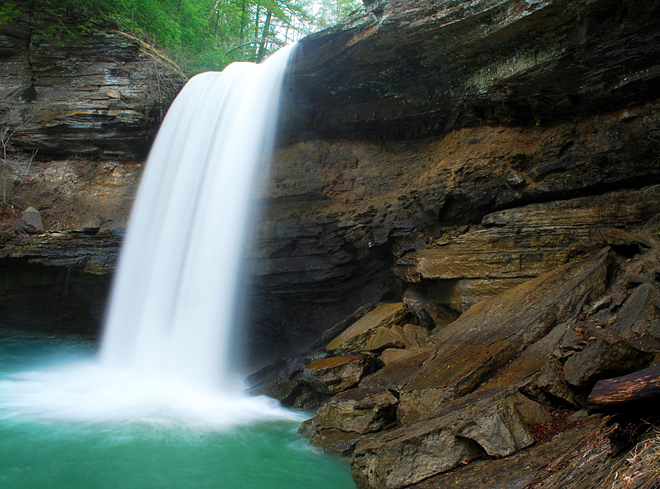
Like a river, time flows over our rocky exteriors, forging an imperceptible constant of change as the seasons pass one by one. Every so often we pause to take stock of those changes, celebrate the good, learn from the bad and marvel at the speed with which the cascade has passed.
Thirty one years ago today, a couple of kids with heads full of dreams joined each other to tackle the rapids together. I'm happy to say those two are still together, ready to face what awaits on our 32nd trip around the sun.
And we're still dreaming.
Happy anniversary, dear.
Photo: Greeter Falls, near Altamont, Tennessee on the Cumberland Plateau. Photograph © 2009 James Jordan.
Labels:
Cumberland Plateau,
Time passages,
water
Friday, June 05, 2009
Facade of justice

The Grundy County Courthouse in Altamont, Tennesee sits on a high point on the Cumberland Plateau, making the structure visible from a distance as you approach from the west. The imposing building is a stark contrast to the small houses, farms and shacks that line state highway 108.

These classic ornate columns were put in place in the mid 1990s when the courthouse was rebuilt following a fire. The original courthouse was built in the late 1800s. The inset photo shows the courthouse from the front lawn at dusk.
As imposing as those in the county government would like the presence of justice to be perceived, stories of corruption within the local law enforcement agencies are common, making the facade of the house of justice just that -- a facade.
Photographs © 2009 James Jordan.
Labels:
Abstract,
Architecture,
Cumberland Plateau,
Twilight
Monday, April 20, 2009
Southern hospitality
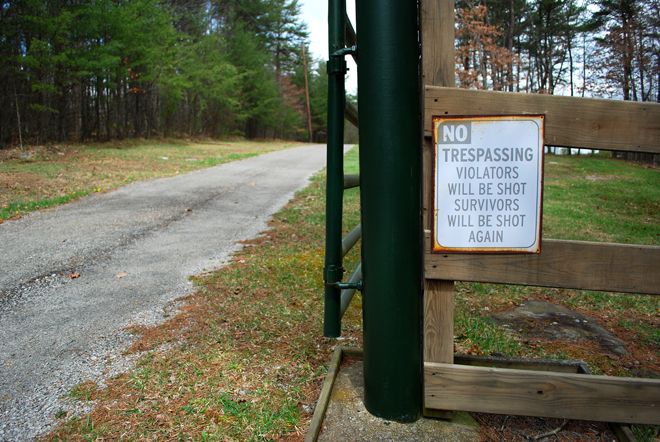
Seen on a rural road in central Tennessee. Paw done got an itchy trigger finger. Y'all don't come back now, y'hear?
Photograph © 2009 James Jordan.
Labels:
Cumberland Plateau,
Path,
Signs of the times
Thursday, April 16, 2009
Light rain
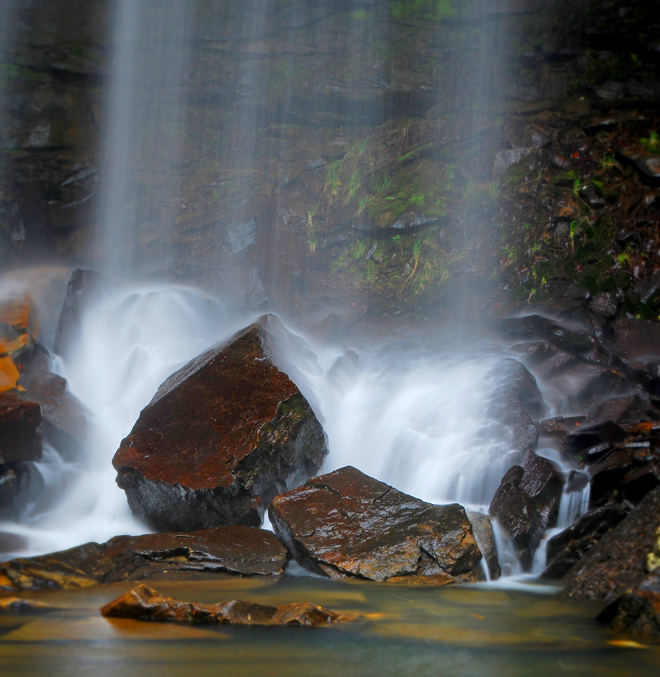
Water flows like liquid light at the base of Suter Falls in the South Cumberland Recreation Area in Tennessee, high on the Cumberland Plateau. The 1000-foot-tall escarpment rises a few miles west of Chattanooga and extends midway across the state, traversing it from north to south and stretching into Alabama and Kentucky.
Numerous rivers and streams cut into the tableland of sandstone and shale, producing hundreds of waterfalls, caves and sinkholes.
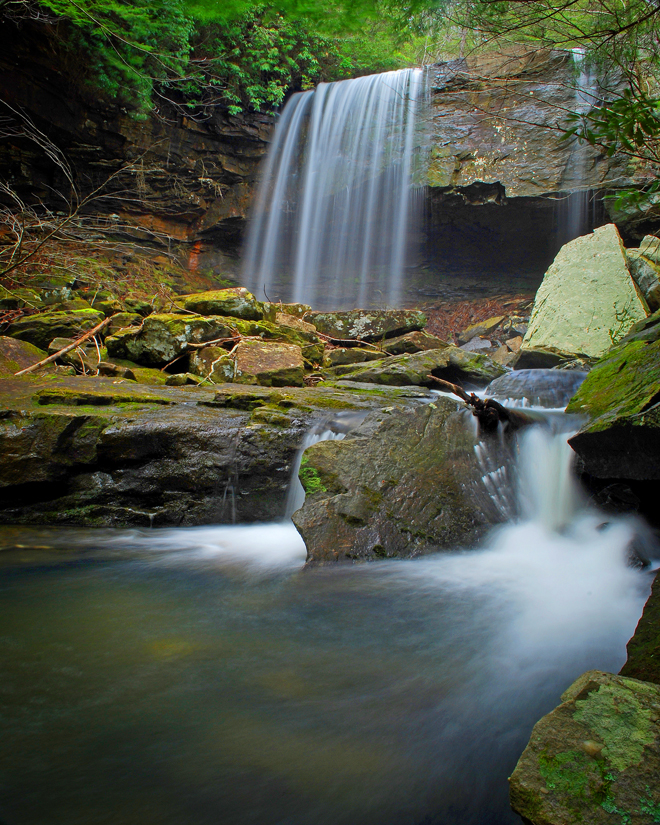
Suter Falls is categorized as a 30- to 50-foot tall waterfall, depending on the water flow over the caprock. Heavier flow pushes the falls out farther and deeper, which is what is was doing when I visited in early spring. The flow eases in the hot summer months and the falls can be nonexistant by early autumn.
For some tips on how to get the most out of shots of moving water, take a look at an article I wrote for Digicamhelp, a web site devoted to beginning-to-intermediate photographers. I'm a contributing writer to the site, which is filled with tons of helpful advice for aspiring shutterbugs. Check it out.
Labels:
Cumberland Plateau,
Link love,
water
Monday, April 13, 2009
Laurel Falls
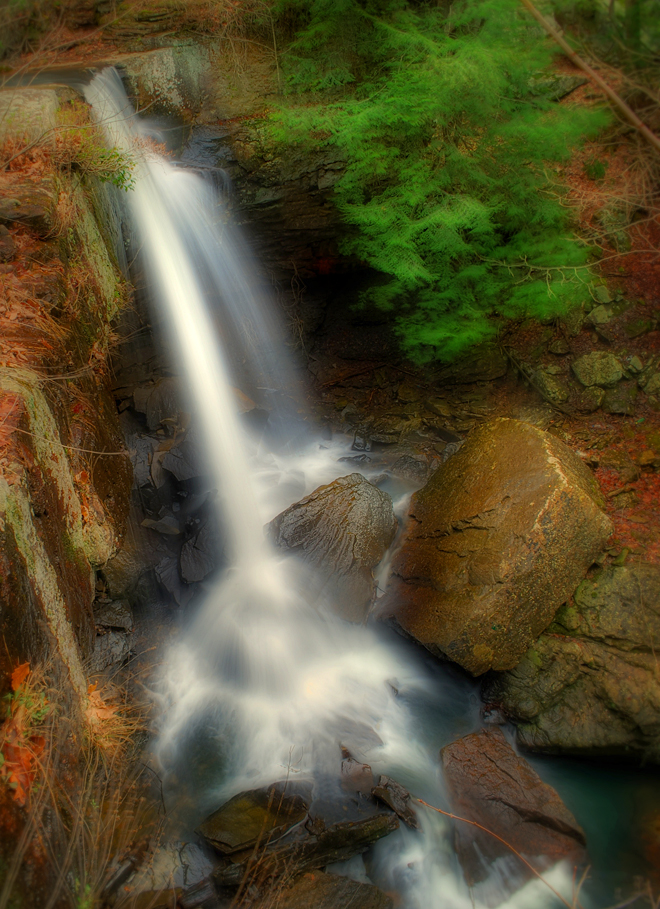
From our recent trip to the Cumberland Plateau in eastern Tennessee. I'm still making my way through hundreds of photos in addition to several dozen more taken since we got back. Whew.
Photograph © 2009 James Jordan.
Labels:
Cumberland Plateau,
Orton,
Spring,
water
Saturday, April 11, 2009
While the stars pass silently by

More abandoned trucks high atop the Cumberland Plateau in Tennessee at night.
Photograph © 2009 James Jordan.
Thursday, April 09, 2009
What'd you expect ...
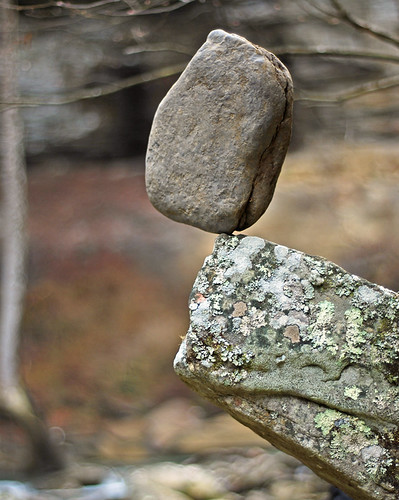
... that I would travel to a place that had a gazillion rocks and not try to balance one ...
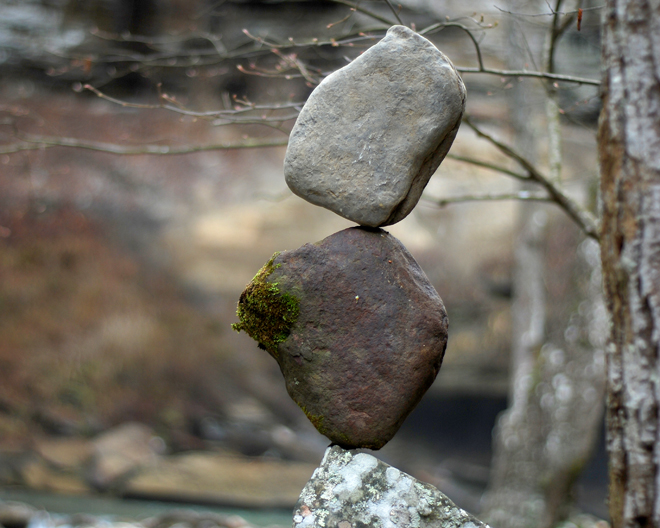
... or two?
The top photo, also posted on Flickr, garnered a comment from Bill Dan, the person who inspired me to give rock balancing a try last year. Bill does some phenomenal rock balancing, and is even branching out into balancing other items. Check out Bill's photos on Flickr.
I've got the spirit: My photograph of the Sturgeon Bay, Wisconsin Pier Lighthouse won the "Spirit of Winter" prize in a competition in the Shield of Excellence group on Flickr. Getting up early in subfreezing weather has its rewards.
Photographs © 2009 James Jordan.
Labels:
Cumberland Plateau,
Depth of Field,
Fun,
Rock Balancing
Wednesday, April 08, 2009
Rod's wrecker redux
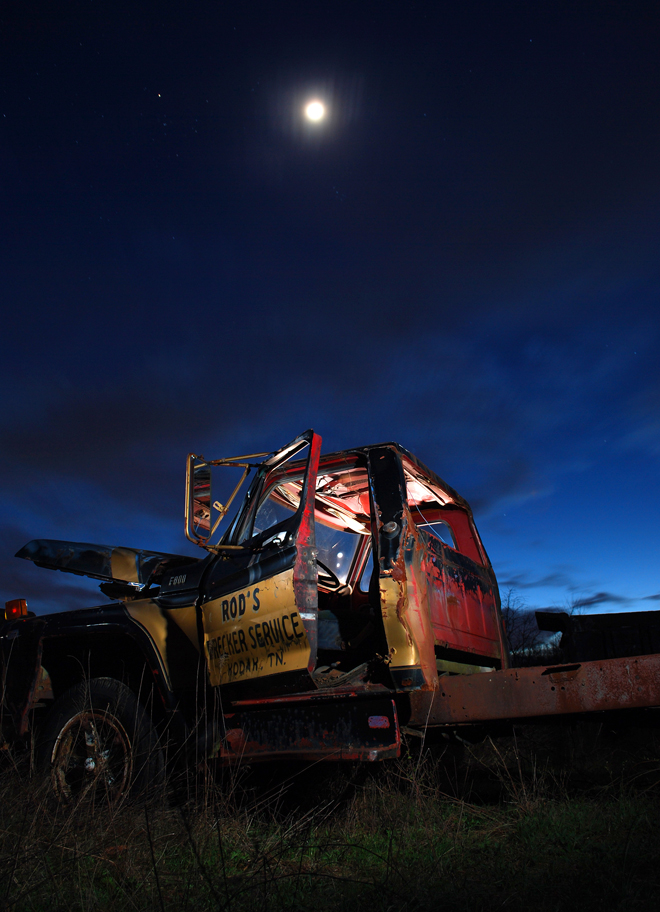
My, oh my!
Look how the time flies.
Look how the world changes
in the blink of an eye.
My, oh my!
Look how the years have flown.
Turnin’ around before you know it --
Up and gone.
Oh my, oh my, oh my.
These lyrics fit the picture of the abandoned old wrecker truck in more ways than one. It's the chorus of a song recorded by a country music duo that called themselves The Wreckers.
Photo blogging: Digicamhelp.com is a Web site devoted to helping beginning to intermediate photography enthusiasts get the most out of their digital camera equipment. I've been a contributing author to the site since January -- you can check out articles on everything from basic exposure and composition to post-processing and visual effects. You can sign up for Digicam's newsletter and alerts for new posted content.
Picture too big? Here's a smaller version. Hand held flash unit fired six times around the truck during a 30 second exposure at deep twilight. Photograph © 2009 James Jordan.
Tuesday, April 07, 2009
Northcutts Cove Chapel
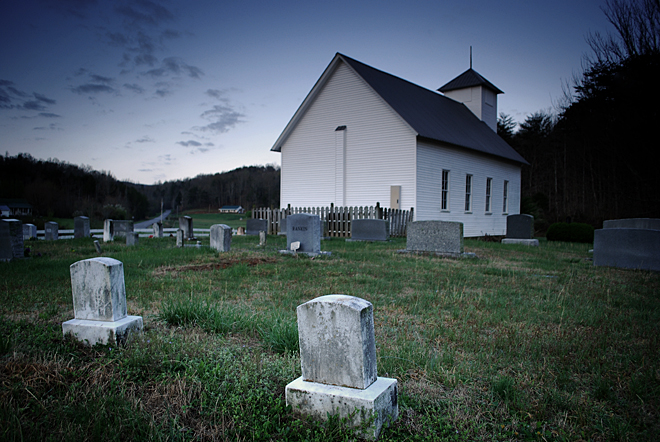
The Cumberland Plateau features communities nestled into the many coves that cut into the rocky outcropping. Northcutts Cove, north of Altamont, is a mixture of farms, new homes and old shacks in a quaint, picturesque setting.
Northcutts Cove Road winds its way from Altamont down the plateau through thick woods. As you enter the clearing of the cove, one of the first sights is the Northcutts Cove Chapel, built by members of the Church of Latter Day Saints in 1909. LDS missionaries began their work in Grundy County, Tennessee two decades earlier. The chapel was built by volunteers who donated the materials for the building.
Shortly after the chapel's opening, a local Church of Christ minister named Mansfield challenged the LDS' southern states leader, Charles Callis, to a debate on the beliefs of Mormonism. The debate took place over the course of three days in October of 1909. Reverend Mansfield was apparently not too successful at dissuading people from their Mormon beliefs since Grundy County to this day has the highest percentage of Mormons in the state of Tennessee.
The cove was named for the Northcutt family. H.B. Northcutt formed a family business of building coffins, which makes a great segue into the photo above, taken behind the chapel in the first light of morning. No doubt some of the Northcutts' handiwork lies beneath the earth's surface in this photograph.
The chapel, along with H. B. Northcutt's home in Altamont, are listed on the National Register of Historic Places.
Photograph © 2009 James Jordan.
Labels:
Church,
Cumberland Plateau,
Golden Hour,
Morning,
Spring
Monday, April 06, 2009
Greeting from Greeter Falls
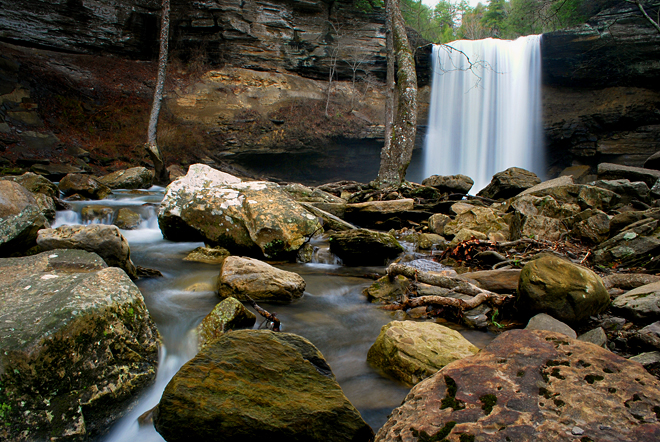
Lower Greeter Falls
The Cumberland Plateau is a vast tableland of sandstone and shale that rises 1000 feet above the Tennessee River Valley and stretches across eastern Tennessee from Alabama north into Kentucky. Over time, flowing water has carved deep ravines, forming a network of hundreds of caves and waterfalls, many of them in remote areas accessible only by long, arduous hikes.
Greeter Falls is located in Grundy County near the town of Altamont and was named for the Greeter family, which owned a nearby homestead. Firescald Creek drops over a 15-foot ledge, advances about 40 yeards, then plunges 50 feet into a pool before continuing along its rocky creekbed to meet Big Creek.
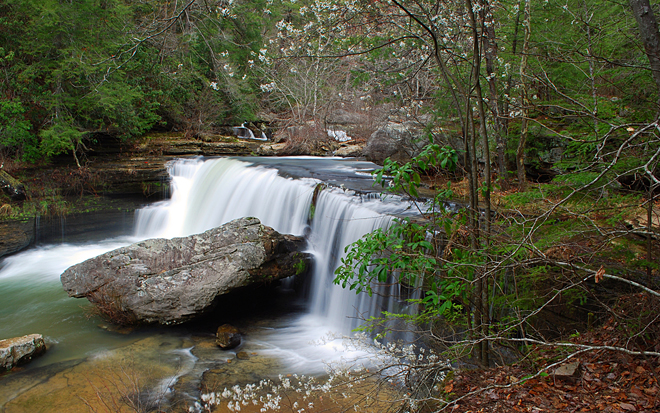
Upper Greeter Falls
Access to Greeter Falls requires a half mile hike through fairly steep terrain and a descent into a gorge via a metal spiral staircase and a set of wooden stairs, which are usually wet from mist from the falls.
Greeter Falls was the first waterfall stop on a recent trip to the Cumberland Plateau and an all-around learning experience in terms of traversing the rugged landscape, caring for camera equipment in a moist environment and exposing the cascading water properly (i.e., mistakes were made here that were corrected at later waterfall stops).
Photographs © 2009 James Jordan.
Labels:
Cumberland Plateau,
Spring,
water
Sunday, April 05, 2009
Under the stars

This old wrecker truck was my muse during evenings on the Cumberland Plateau in south central Tennessee last week. I spent the daylight hours wandering some of the backroads or exploring hiking trails that provided views of high bluffs, rocky coves and roaring streams tumbling over stony outcroppings while making their way down to the valleys 1000 feet below.
When night fell, I turned my attention to several abandoned trucks on the property adjacent to the place my wife and I stayed. I experimented with an old flash unit, which I fired by hand while walking around the vehicles during long exposures. Clear moonless nights on the plateau revealed an amazing array of stars, which I wanted to capture.
The plateau is wild and rugged. The people who live in small towns are descendents of the first settlers who tried to wrest a living from the rocky soils, abundant trees and veins of coal in the area. Some succeed, many fail, as attested by the numerous decrepit shacks along the roadways. At the same time, development is creeping atop the plateau as people discover a place to build second homes in advance of their retirement.
Over the next couple of weeks, I'll share photographs and thoughts picked up from one of the largest geographical areas of its kind in the world -- and one that most people have never heard of.
Photo info: Exposure - 1 1/2 minutes at f5.6, ISO 400. Hand-held flash unit fired six times - three times at the front and side of the truck, twice inside the cab with a blue filter placed over the light and once under the hood. Photograph © 2009 James Jordan.
Subscribe to:
Posts (Atom)




